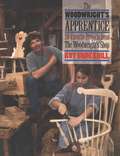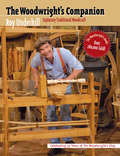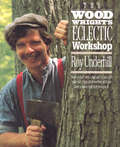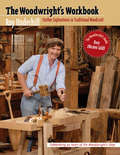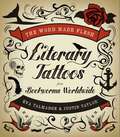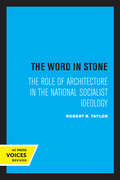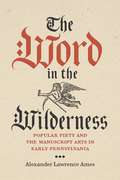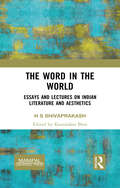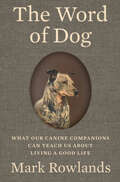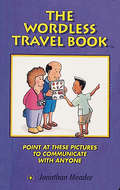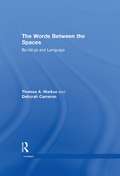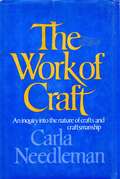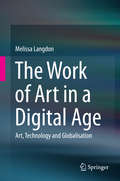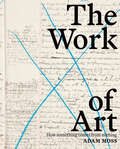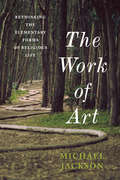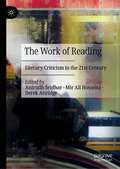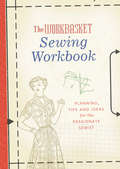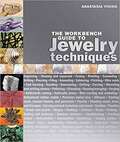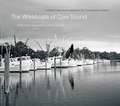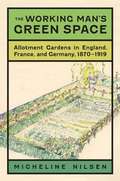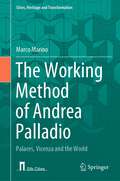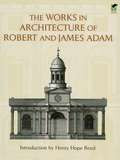- Table View
- List View
The Woodwright's Apprentice
by Roy UnderhillFor more than twenty years, Roy Underhill has taught the techniques of traditional woodcraft with muscle-powered tools. With his four previous books and his popular PBS series, The Woodwright's Shop, now in its sixteenth season, Roy has inspired millions to take up chisel and plane. The master woodwright returns here with instructions for handcrafting an appealing selection of projects from the American woodworking tradition. The Woodwright's Apprentice begins with directions for building a workbench. Each successive project builds new skills for the apprentice woodworker--from frame construction to dovetailing, turning, steam-bending, and carving. Among the twenty items featured are an African chair, a telescoping music stand, a walking-stick chair, a fireplace bellows, and a revolving Windsor chair. Designed both for woodworking novices and for more seasoned woodworkers looking for enjoyable projects, the book includes step-by-step directions, complete with easy-to-follow photographs and measured drawings, and an illustrated glossary of tools and terms. All of the pieces presented here are based on projects featured in past and upcoming seasons of The Woodwright's Shop television show.
The Woodwright's Companion
by Roy UnderhillWith The Woodwright's Companinon, Roy Underhill continues to demonstrate "how to start with a tree and an axe and make one thing after another until you have a house and everything in it." This volume features chapters on helves and handles, saws, the search for the whetstone quarry, crow chasers and turkey calls, hurdles, whimmy diddles, snaplines and marking gauges, candle stands, planes, window sash, riven shingles, and pit sawing. The final chapter offers a glimpse of traditional woodworking techniques still used by the Colonial Williamsburg housewrights. More than 260 photographs complement the text.
The Woodwright's Eclectic Workshop
by Roy UnderhillFor more than ten years, Roy Underhill has taught the techniques of traditional woodcraft, or 'how to start with a tree and an axe and make one thing after another until you have a house and everything in it.' Through his popular PBS series, The Woodwright's Shop,' and his previous books, Roy has inspired millions--from professional craftspeople to armchair woodworkers--with his talent, knowledge, and enthusiasm. Roy returns now with his fourth book, The Woodwright's Eclectic Workshop. It features step-by-step instructions for many projects featured on the television series in recent years, including such popular projects as the Adirondack chair, tavern table, folding ladder, rocking horse, lathe, and kayak. All projects are illustrated with photographs and measured drawings. The book also includes colorful descriptions of what it was like to be a tradesperson who made a living by hand, working with the tools and methods Roy describes on television and in his books: carpenters, joiners, wheelwright, millwrights, chairmakers, and blacksmiths. As Roy puts it, he wants to examine 'the old paths in the way that they were originally taken: not as adventuresome recreations but a profession that put food on the table and clothes on the kids.'
The Woodwright's Shop
by Roy UnderhillRoy Underhill brings to woodworking the intimate relationship with wood that craftsmen enjoyed in the days before power tools. Combining historical background, folklore, alternative technololgy, and humor, he provides both a source of general information and a detailed introduction to traditional woodworking. Beginning with a guide to trees and tools, The Woodwright's Shop includes chapters on gluts and mauls, shaving horses, rakes, chairs, weaving wood, hay forks, dough bowls, lathes, blacksmithing, dovetails, panel-frame construction, log houses, and timber-frame construction. More than 330 photographs illustrate the text.For more than twenty-five years, Roy Underhill has taught the techniques of traditional hand-tool woodworking. In five books and on his popular, long-running PBS series, The Woodwright's Shop, America's leading authority on old-time woodcraft has inspired millions to take up chisel and plane. Designed for both woodworking novices and for more seasoned woodworkers looking for enjoyable projects, the books feature step-by-step instructions, complete with easy-to-follow photographs and measured drawings. Roy Underhill is the former master housewright at Colonial Williamsburg. He created The Woodwright's Shop, one of the first television programs devoted to woodworking, in 1979. The series is produced by the University of North Carolina Center for Public Television and has aired nationally since 1981. Roy is a graduate of the University of North Carolina at Chapel Hill and holds a master's degree from Duke University. He lives in Williamsburg, Virginia.The Woodwright's ShopA Practical Guide to Traditional WoodcraftFeatures a guide to trees and tools as well as chapters on gluts and mauls, shaving horses, chairs, lathes, blacksmithing, log houses, and more.The Woodwright's CompanionExploring Traditional WoodcraftIncludes chapters on helves and handles, saws, the search for the whetstone quarry, hurdles, whimmy diddles, planes, window sashes, and pit sawing.The Woodwright's WorkbookFurther Explorations in Traditional WoodcraftWith step-by-step instructions for tool chests, workbenches, lathes, and historical reproductions of items for the home. Roy also explores building barns, boats, and even colonial fortresses.The Woodwright's Eclectic WorkshopPopular projects include the Adirondack chair, tavern table, folding ladder, rocking horse, lathe, and kayak, all illustrated with photographs and measured drawings. The Woodwright's ApprenticeTwenty Favorite Projects from The Woodwright's ShopBegins with directions for building a workbench, then builds new skills--from frame construction to dovetailing, turning, steam-bending, and carving--with each successive project.-->
The Woodwright's Workbook
by Roy UnderhillRoy Underhill is America's best-known master of traditional woodcraft. Creator of the popular PBS series The Woodwright's Shop, Roy has inspired millions--from professional craftsman to armchair woodworker--with his talent, knowledge, and enthusiasm. Roy returns here with his third book. The Woodwright's Workbook features step-by-step instructions for a selection of projects from his television series. All projects are illustrated with photographs and measured drawings. Included here are plans for tool chests, workbenches, lathes, and historical reproductions of items for the home: a six-board chest, rustic chairs with cattail seats, a churn for the kitchen, and the Rittenhouse hygrometer. Roy also explores building barns, forges, boats, and even colonial fortresses. A wonderful feature of this book is Roy's own translation of the humorous fifteenth-century poem The Debate of the Carpenter's Tools. He also provides a fascinating and useful 'field guide' to American tool marks that shows how to identify the specific tool used by the marks it left. Whether Roy is an old friend or a new acquaintance, let him be your guide to the world of traditional woodworking.
The Woodwright’s Guide
by Roy UnderhillFor thirty years, Roy Underhill's PBS program, The Woodwright's Shop, has brought classic hand-tool craftsmanship to viewers across America. Now, in his seventh book, Roy shows how to engage the mysteries of the splitting wedge and the cutting edge to shape wood from forest to furniture.Beginning with the standing tree, each chapter of The Woodwright's Guide explores one of nine trades of woodcraft: faller, countryman and cleaver, hewer, log-builder, sawyer, carpenter, joiner, turner, and cabinetmaker. Each trade brings new tools and techniques; each trade uses a different character of material; but all are united by the grain in the wood and the enduring mastery of muscle and steel.Hundreds of detailed drawings by Eleanor Underhill (Roy's daughter) illustrate the hand tools and processes for shaping and joining wood. A special concluding section contains detailed plans for making your own foot-powered lathes, workbenches, shaving horses, and taps and dies for wooden screws.The Woodwright's Guide is informed by a lifetime of experience and study. A former master craftsman at Colonial Williamsburg, Roy has inspired millions to "just say no to power tools" through his continuing work as a historian, craftsman, activist, and teacher. In The Woodwright's Guide, he takes readers on a personal journey through a legacy of off-the-grid, self-reliant craftsmanship. It's a toolbox filled with insight and technique as well as wisdom and confidence for the artisan in all of us.
The Word Made Flesh
by Justin Taylor Eva TalmadgeThe Word Made Flesh: Literary Tattoos from Bookworms Worldwide is a guide to the emerging subculture of literary tattoos-a collection of more than 150 full-color photographs of human epidermis indelibly adorned with quotations and illustrations from Dickinson to Pynchon, from Shakespeare to Plath. With beloved lines of verse, literary portraits, and illustrations-and statements from the bearers on their tattoos' history and the personal significance of the chosen literary work-The Word Made Flesh is part collection of photographs and part literary anthology written on skin.
The Word in Stone: The Role of Architecture in the National Socialist Ideology
by Robert R. TaylorThis title is part of UC Press's Voices Revived program, which commemorates University of California Press’s mission to seek out and cultivate the brightest minds and give them voice, reach, and impact. Drawing on a backlist dating to 1893, Voices Revived makes high-quality, peer-reviewed scholarship accessible once again using print-on-demand technology. This title was originally published in 1974.
The Word in the Wilderness: Popular Piety and the Manuscript Arts in Early Pennsylvania (Pietist, Moravian, and Anabaptist Studies #5)
by Alexander Lawrence AmesOnce a vibrant part of religious life for many Pennsylvania Germans in the eighteenth and nineteenth centuries, Fraktur manuscripts today are primarily studied for their decorative qualities. The Word in the Wilderness takes a different view, probing these documents for what they tell us about the lived religious experiences of the Protestant communities that made and used them and opening avenues for reinterpretation of this well-known, if little understood, set of cultural artifacts.The resplendent illuminated religious manuscripts commonly known as Fraktur have captivated collectors and scholars for generations. Yet fundamental questions about their cultural origins, purpose, and historical significance remain. Alexander Lawrence Ames addresses these by placing Fraktur manuscripts within a "Pietist paradigm," grounded in an understanding of how their makers viewed "the Word," or scripture. His analysis combines a sweeping overview of Protestant Christian religious movements in Europe and early America with close analysis of key Pennsylvania devotional manuscripts, revealing novel insights into the religious utility of calligraphy, manuscript illumination, and devotional reading as Protestant spiritual enterprises. Situating the manuscripts in the context of transatlantic religious history, early American spirituality, material culture studies, and the history of book and manuscript production, Ames challenges long-held approaches to Pennsylvania German studies and urges scholars to engage with these texts and with their makers and users on their own terms. Featuring dozens of illustrations, this lively, engaging book will appeal to Fraktur scholars and enthusiasts, historians of early America, and anyone interested in the material culture and spiritual practices of the German-speaking residents of Pennsylvania.
The Word in the Wilderness: Popular Piety and the Manuscript Arts in Early Pennsylvania (Pietist, Moravian, and Anabaptist Studies #5)
by Alexander Lawrence AmesOnce a vibrant part of religious life for many Pennsylvania Germans in the eighteenth and nineteenth centuries, Fraktur manuscripts today are primarily studied for their decorative qualities. The Word in the Wilderness takes a different view, probing these documents for what they tell us about the lived religious experiences of the Protestant communities that made and used them and opening avenues for reinterpretation of this well-known, if little understood, set of cultural artifacts.The resplendent illuminated religious manuscripts commonly known as Fraktur have captivated collectors and scholars for generations. Yet fundamental questions about their cultural origins, purpose, and historical significance remain. Alexander Lawrence Ames addresses these by placing Fraktur manuscripts within a “Pietist paradigm,” grounded in an understanding of how their makers viewed “the Word,” or scripture. His analysis combines a sweeping overview of Protestant Christian religious movements in Europe and early America with close analysis of key Pennsylvania devotional manuscripts, revealing novel insights into the religious utility of calligraphy, manuscript illumination, and devotional reading as Protestant spiritual enterprises. Situating the manuscripts in the context of transatlantic religious history, early American spirituality, material culture studies, and the history of book and manuscript production, Ames challenges long-held approaches to Pennsylvania German studies and urges scholars to engage with these texts and with their makers and users on their own terms. Featuring dozens of illustrations, this lively, engaging book will appeal to Fraktur scholars and enthusiasts, historians of early America, and anyone interested in the material culture and spiritual practices of the German-speaking residents of Pennsylvania.
The Word in the World: Essays and Lectures on Indian Literature and Aesthetics
by H S ShivaprakashThe Word in the World is a collection of essays and lectures by H S Shivaprakash, a well-known poet, playwright, and translator. Edited by Kamalakar Bhat, this book brings together Prof Shivaprakash’s interventions in the realm of issues that are entwined with the continuities and discontinuities in the cultural negotiations of India. Distinctively, these are essays on subjects ranging from the nature and significance of medieval works of literature in India to issues arising out of developments in Indian aesthetics. The unfeigned magnitude of this work must be found among students and scholars, who will gain from it a perspective significantly different from the ones available in the prevailing academic discourses, thus indicating a way beyond poststructuralist/postmodernist frameworks. This is a book that will interest a wide variety of readers with its engaging insights and breadth of reference especially because it is written in a comprehensible style. Print edition not for sale in South Asia (India, Sri Lanka, Nepal, Bangladesh, Pakistan and Bhutan)
The Word of Dog: What Our Canine Companions Can Teach Us About Living a Good Life
by Mark RowlandsA heartwarming philosophical meditation on how to live a fulfilling life—inspired by the inherent happiness of dogs. If you have spent any part of your life with a dog, you may have found certain questions popping, unbidden, into your mind: Is my dog living a fulfilled life? Is my dog a good dog? Does my dog love me? Addressing these questions compels you to confront not just your dog’s life but yours as well—to think about what fulfillment, and meaning, in life really is. In The Word of Dog, philosopher Mark Rowlands explores these questions and suggests that in dogs we can see hints—faint, shrouded, but discernible—of what a better way of living might look like. Perhaps none of us can be happy in the way a dog can, but The Word of Dog shows us we could do a lot better than we’re doing simply by listening to the unspoken wisdom our dogs reveal to us every day of their happy, uncomplicated lives.
The Wordless Travel Book: Point at These Pictures to Communicate with Anyone
by Jonathan MeaderIt is a unique triumph for us to present a travel book that helps you communicate without words! All you need to do is point at the icons contained in this inventive little book, and you'll be able to speak a foreign language and be understood. Encased in a sturdy clear plastic jacket for easy travel.From the Trade Paperback edition.
The Words Between the Spaces: Buildings and Language (Architext)
by Deborah Cameron Thomas A. MarkusUsing language - speaking and understanding it - is a defining ability of human beings, woven into all human activity. It is therefore inevitable that it should be deeply implicated in the design, production and use of buildings. Building legislation, design guides, competition and other briefs, architectural criticism, teaching and scholarly material, and the media all produce their characteristic texts.The authors use texts about such projects as Berlin's new Reichstag, Scotland's new Parliament, and the Auschwitz concentration camp museum to clarify the interaction between texts, design, critical debate and response.
The Work Of Craft
by Carla NeedlemanThe Work of Craft is a profound meditation on the relationship between craft and craftsman. Focusing in turn on pottery, weaving, and woodcarving, and grounding her insights in her own experiences as a potter, Carla Needleman shows that the basic material every craftsman works with is himself or herself. The stuff between one's hands-the clay, the wood, the wool-responds to the quality of one's inner state. The product of one's work is not just an object but a way of being. Thus, the exploration of a craft is--like this book--an exploration of the processes of life itself.
The Work of Art in a Digital Age: Art, Technology and Globalisation
by Melissa LangdonThis book explores digital artists' articulations of globalization. Digital artworks from around the world are examined in terms of how they both express and simulate globalization's impacts through immersive, participatory and interactive technologies. The author highlights some of the problems with macro and categorical approaches to the study of globalization and presents new ways of seeing the phenomenon as a series of processes and flows that are individually experienced and expressed. Instead of providing a macro analysis of large-scale political and economic processes, the book offers imaginative new ways of knowing and understanding globalization as a series of micro affects. Digital art is explored in terms of how it re-centers articulations of globalization around individual experiences and offers new ways of accessing a complex topic often expressed in general and intangible terms. The Work of Art in a Digital Age: Art, Technology and Globalization is analytic and accessible, with material that is of interest to a range of researchers from different disciplines. Students studying digital art, film, globalization, cultural studies or digital media trends will also find the content fascinating.
The Work of Art: How Something Comes from Nothing
by Adam MossTHE NEW YORK TIMES BESTSELLER <p><p> “The book is a visual feast, full of drafts, sketches, and scribbled notebook pages. Every page shows how an idea becomes a finished design.&” —Ari Shapiro, All Things Considered. <p> From former editor of New York magazine Adam Moss, a collection of illuminating conversations examining the very personal, rigorous, complex, and elusive work of making art. What is the work of art? In this guided tour inside the artist’s head, Adam Moss traces the evolution of transcendent novels, paintings, jokes, movies, songs, and more. Weaving conversations with some of the most accomplished artists of our time together with the journal entries, napkin doodles, and sketches that were their tools, Moss breaks down the work—the tortuous paths and artistic decisions—that led to great art. From first glimmers to second thoughts, roads not taken, crises, breakthroughs, on to one triumphant finish after another. <p><p> Featuring: Kara Walker, Tony Kushner, Roz Chast, Michael Cunningham, Moses Sumney, Sofia Coppola, Stephen Sondheim, Susan Meiselas, Louise Glück, Maria de Los Angeles, Nico Muhly, Thomas Bartlett, Twyla Tharp, John Derian, Barbara Kruger, David Mandel, Gregory Crewdson, Marie Howe, Gay Talese, Cheryl Pope, Samin Nosrat, Joanna Quinn & Les Mills, Wesley Morris, Amy Sillman, Andrew Jarecki, Rostam, Ira Glass, Simphiwe Ndzube, Dean Baquet & Tom Bodkin, Max Porter, Elizabeth Diller, Ian Adelman / Calvin Seibert, Tyler Hobbs, Marc Jacobs, Grady West (Dina Martina), Will Shortz, Sheila Heti, Gerald Lovell, Jody Williams & Rita Sodi, Taylor Mac & Machine Dazzle, David Simon, George Saunders, Suzan-Lori Parks <p><p> <b>New York Times Bestseller</b>
The Work of Art: Rethinking the Elementary Forms of Religious Life (Insurrections: Critical Studies in Religion, Politics, and Culture)
by Professor Michael D. JacksonHow are we to think of works of art? Rather than treat art as an expression of individual genius, market forces, or aesthetic principles, Michael Jackson focuses on how art effects transformations in our lives. Art opens up transitional, ritual, or utopian spaces that enable us to reconcile inward imperatives and outward constraints, thereby making our lives more manageable and meaningful. Art allows us to strike a balance between being actors and being acted upon. Drawing on his ethnographic fieldwork in Aboriginal Australia and West Africa, as well as insights from psychoanalysis, religious studies, literature, and the philosophy of art, Jackson deploys an extraordinary range of references—from Bruegel to Beuys, Paleolithic art to performance art, Michelangelo to Munch—to explore the symbolic labor whereby human beings make themselves, both individually and socially, out of the environmental, biographical, and physical materials that affect them: a process that connects art with gestation, storytelling, and dreaming and illuminates the elementary forms of religious life.
The Work of Reading: Literary Criticism in the 21st Century
by Derek Attridge Anirudh Sridhar Mir Ali HosseiniThe Work of Reading: Literary Criticism in the 21st Century is a sustained critical examination of the developments in the field of literary studies from the early 2000s onwards within the context of the systematic problems in the humanities. This volume analyzes the origins of the current methods—including New Historicism, empiricism, New Formalism, postcritique, and others—and posits alternatives to the present state of literary studies. At a time when many aspects of current methods show a desire to adopt values from other disciplines to solve internal crises, this volume advocates a renewed focus on questions of form by means of the praxis of aesthetic study, close reading, and other modes of engaging directly with literary texts.
The Workbasket Sewing Workbook: Planning, Tips and Ideas
by Bethany AndersonThe WORKBASKET magazine inspired readers for sixty-one years. It was the go-to for "Ideas for the Bazaar, the Home, Gifts and Sparetime Money-makers - with Many Inexpensive, Easily Made Articles that find a Ready Sale." For generations, The WORKBASKET inspired with endless projects and suggestions in sewing, knitting, crochet, quilting, embroidery and many other fun crafts. Inside The WORKBASKET Sewing Workbook you'll be treated to the illustrations and content of The WORKBASKET magazine from its coolest years: the 1940s through the 1960s. During this time the magazine featured fabulous illustrations of women in dresses, as well as inspirational "Women Who Make Cents" stories and great sewing content. The best of this material, as well as worksheets and charts, are here to help you track your sewing projects and inspire you to get sewing!
The Workbench Guide to Jewelry Techniques
by Anastasia YoungThis comprehensive and ambitious workshop reference for jewelers brings together a vast range of skills, techniques, and technical data into one volume. <p><p> Offering detailed explanations and step-by-step photography to demonstrate procedures, this handbook includes a complete reference section featuring tool shapes, an index of gems, a glossary, standard sizes and measurements, conversion tables, and an extensive list of resources. Additionally, the manual offers a directory of tools and materials--including a key to identifying tools for a "beginner's kit"--a historical introduction to jewelry, and suggestions for photographing and promoting completed pieces. Remarkable cutting-edge pieces by jewelry makers and designers from around the world are used to illustrate the various processes involved in creating exceptional jewelry. <p><p> Covering everything from traditional metalsmithing skills and using alternative materials, such as plastics and resin, to discussing issues involved with outsourcing work to specialist external suppliers, this is an indispensable and essential resource for both students and professionals.
The Workboats of Core Sound
by Lawrence S. EarleyAlong the wide waters of eastern North Carolina, the people of many scattered villages separated by creeks, marshes, and rivers depend on shallow-water boats, both for their livelihoods as fishermen and to maintain connections with one another and with the rest of the world. As Lawrence S. Earley discovered, each workboat has stories to tell, of boatbuilders and fishermen, and of family members and past events associated with these boats. The rich history of these hand-built wooden fishing boats, the people who work them, and the communities they serve lies at the heart of Earley's evocative new book of essays, interviews, and photographs.In conversations with the region's fishermen and boatbuilders, the author finds webs of decades-old social history and realizes that workboats are critical in maintaining a community's memories and its very sense of identity. Including nearly 100 of Earley's own striking duotones, this richly illustrated book brings to life the world of a fishing culture threatened by local and global forces.
The Working Man's Green Space
by Micheline NilsenWith antecedents dating back to the Middle Ages, the community garden is more popular than ever as a means of procuring the freshest food possible and instilling community cohesion. But as Micheline Nilsen shows, the small-garden movement, which gained impetus in the nineteenth century as rural workers crowded into industrial cities, was for a long time primarily a repository of ideas concerning social reform, hygienic improvement, and class mobility. Complementing efforts by worker cooperatives, unions, and social legislation, the provision of small garden plots offered some relief from bleak urban living conditions. Urban planners often thought of such gardens as a way to insert "lungs" into a city.Standing at the intersection of a number of disciplines--including landscape studies, horticulture, and urban history-- The Working Man's Green Space focuses on the development of allotment gardens in European countries in the nearly half-century between the Franco-Prussian War and World War I, when the French Third Republic, the German Empire, and the late Victorian era in England saw the development of unprecedented measures to improve the lot of the "laboring classes." Nilsen shows how community gardening is inscribed within a social contract that differs from country to country, but how there is also an underlying aesthetic and social significance to these gardens that transcends national borders.
The Working Method of Andrea Palladio: Palaces, Vicenza and the World (Cities, Heritage and Transformation)
by Marco MarinoThis book shows through historical data, diagrams and drawings, the design system of an Italian historic center, that of Vicenza, Italy. Vicenza is the result of an urban construction process that has as its model the invention of the Palladian design system. The main argument is how the architectural vision of Andrea Palladio shaped Vincenza to the city it is today. Vicenza is an example of a collective dream, an expression of the best Renaissance artistic culture, a classic example that a city can reform itself through intellectual activity.
The Works in Architecture of Robert and James Adam (Dover Architecture)
by James Adam Robert Adam Henry Hope ReedThe Palladian style dominated British architecture for most of the 1700s, until the rise of the Adam style, which held sway for the final decades of the eighteenth century. Brothers Robert and James Adam were almost single-handedly responsible for infusing Georgian architecture with the sensibilities and elements of classical Hellenic and Latinate design. Their elegant, sophisticated form of Neoclassicism affected not only architecture, but also interior design, furniture design, and landscaping.The Works in Architecture of Robert and James Adam, one of the most celebrated books in architectural history, consists of the brothers' own selections of illustrations from their commissions. Dating from the 1770s, these 106 illustrated plates epitomize the style that influenced generations of British and American architectural and furniture designs. Created by some of the finest commercial engravers of the age -- including four plates by Piranesi -- these illustrations are painstakingly reproduced in perfect detail and clarity. The original text imparts the Adams' own esthetic and practical aims, and an informative introduction places the brothers' work in historical perspective.
